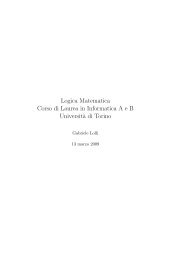Applicazioni della teoria del minimax a problemi ... - Portale Posta DMI
Applicazioni della teoria del minimax a problemi ... - Portale Posta DMI
Applicazioni della teoria del minimax a problemi ... - Portale Posta DMI
You also want an ePaper? Increase the reach of your titles
YUMPU automatically turns print PDFs into web optimized ePapers that Google loves.
66 Capitolo 5. Problemi con due parametri<br />
(5.23.2) per ogni λ ∈ [λ0, λ1] e ogni G come sopra, verificante anche<br />
G(s) ≤ h(1 + s 2 ) per ogni s ∈ R,<br />
esiste µ2 > 0 tale che per ogni µ ∈]0, µ2[ il problema (5.46) ammette almeno tre<br />
soluzioni in C ∩ B(0, σ2).<br />
Dimostrazione. Proviamo (5.23.1) applicando il Teorema 5.2 e il Lemma 5.3: X è uno<br />
spazio di Hilbert separabile, I è localmente lipschitziano e sequenzialmente debolmente<br />
s.c.i., J è localmente lipschitziano e sequenzialmente debolmente continuo (Lemma 5.20),<br />
C è non vuoto, chiuso e convesso; inoltre, scelto δ come nel Lemma 5.22 e definita ψ<br />
ponendo per ogni (u, λ) ∈ X × Λ<br />
ψ(u, λ) = I(u) + λ(δ − J(u)) + χC(u),<br />
dai Lemmi 5.22 e 5.3 segue la condizione (5.2.1); infine, da (5.20.1) segue immediatamente<br />
(5.2.2).<br />
Siano dunque λ0, λ1 ∈ Λ (possiamo supporre λ0 > 0) e σ1 > 0 come nel Teorema 5.2:<br />
dati λ ∈ [λ0, λ1] e G come in (5.23.1), si ponga<br />
Φ = −JG;<br />
allora, Φ è localmente lipschitziano e sequenzialmente debolmente continuo (Lemma 5.21),<br />
sicché esiste µ1 > 0 tale che per ogni µ ∈]0, µ1[ il funzionale ψ(·, λ)+µΦ(·) ammette almeno<br />
due punti di minimo locale u0, u1 ∈ C ∩ B(0, σ1).<br />
Poiché per ogni u ∈ X si ha<br />
Eλ,µ(u) = ψ(u, λ) + µΦ(u) − λδ,<br />
segue che u0 e u1 sono punti di minimo locale per Eλ,µ, e quindi soluzioni di (5.46).<br />
Come al solito, la parte <strong>del</strong>icata è la dimostrazione <strong><strong>del</strong>la</strong> seconda parte <strong><strong>del</strong>la</strong> tesi: ad<br />
essa premettiamo alcuni passaggi, fissando λ0, λ1, σ1 come in (5.23.1).<br />
<br />
Sia ¯µ ∈ 0, 2<br />
<br />
e sia per ogni t > 0<br />
h<br />
ovviamente,<br />
ϑ(t) =<br />
<br />
1 1<br />
−<br />
2 4 ¯µh<br />
<br />
t 2 − λ1h<br />
2q tq − (λ1 + ¯µ)h;<br />
(5.48) lim ϑ(t) = +∞,<br />
t→+∞<br />
sicché, posto<br />
R = σ2 1<br />
2<br />
<br />
+ λ1h 1 + σq 1<br />
2q <br />
+ ¯µh 1 + σ2 <br />
1<br />
,<br />
4




![Introduzione ai sistemi Wiki [PDF] - Mbox.dmi.unict.it](https://img.yumpu.com/16413205/1/184x260/introduzione-ai-sistemi-wiki-pdf-mboxdmiunictit.jpg?quality=85)












